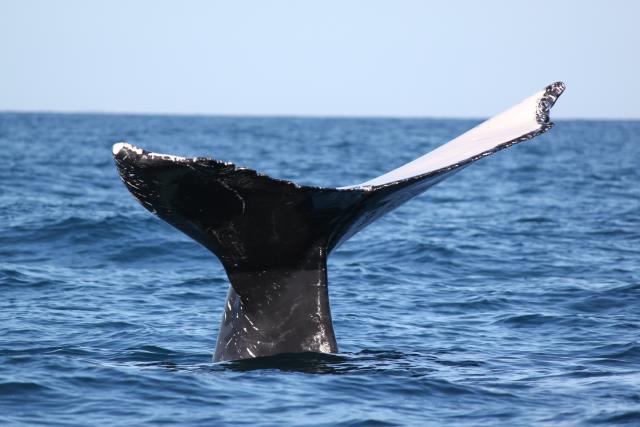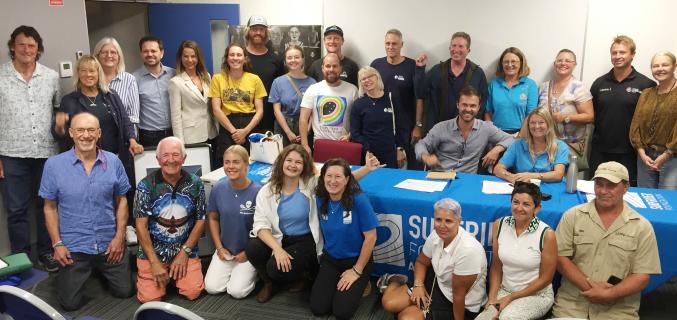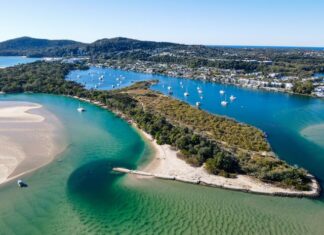The entanglement of a whale calf in shark nets on Main Beach last week drove home the importance for stakeholders to bring together factual data, community education and, as a united front, find an alternative solution to the nets during whale migration to keep both humans and marine life safe at Noosa beaches.
Led by Surfrider Foundation Australia secretary Caz Lansdown, Noosa MP Sandy Bolton and Noosa councillor Amelia Lorentson a meeting was called to discuss the shark nets. Invitations were sent to 22 Noosa organisations, including SLSC, Noosa Biosphere Reserve Foundation, Sea Shepherd, tour operators, scientists, conservationists, wildlife rescuers and surfers.
Caz said we know our nets are a problem, research is showing us they are not protecting swimmers but they are causing problems for wildlife.
“We didn’t only ask people who wanted the nets out, we invited a lot of people so we could get lots of views from lots of people,“ she said.
“We’ll take everything on board and with all the information we can put together a plan on how to proceed from here.“
Sandy Bolton chaired the vibrant and important discussion, describing the meeting as an excellent example of how community can work together to seek a reduction in the trauma to our marine wildlife, residents and visitors by the nets, whilst seeking similar levels of safety.
“To pilot a transition to alternative shark control measures during whale migration season, we need a united request to the state government based on data and facts. This requires support from the wider community and key stakeholders including Noosa Council, as local government support is instrumental in state government determining where trials and transitions occur across the state,” she said.
A number of people at the meeting had witnessed the whale calf entangled in the nets earlier in the day and spoke of how distressing and devastating it had been to hear the young whale’s cries for help and see the net encasing it as it thrashed around, as it probably had for hours, in vain, to free itself.
Conservationist Bernard Jean called it appalling and tragic, saying no one knows the impact on the calf.
Sea Shepherd volunteer Taylor Ladd-Hudson said she had been devastated by the entanglement which had been reported at 5am with the calf released at 7.30am, 15mins after the shark net contractors arrived.
During the event wildlife rescuer Jarrah Small, 14, went to Main Beach with a sign “telling people there was a whale entangled now“ to make them aware of what was going on. Everyone was in support of getting rid of the nets,” she said. “Everyone had no idea a few hundred metres out there was a whale calf fighting for its life.“
In the past 12 months seven humpback whales have been entangled in shark nets on the Sunshine Coast.
Johnny Fell of Sunreef Mooloolaba said two days earlier another calf had become entangled at Mooloolaba and he’d received calls from distressed visitors, saying they had heard the mother screaming for hours on end.
Johnny said humpback whales were the only bycatch in the nets the public were aware of because their splashing made them visible from the shore.
From 2001-2023 there have been 18,000 animals caught in the shark nets of which 17,000 were vulnerable, threatened or endangered, he said.
“Being in the business of tourism and biodiversity, our whole business depends on biodiversity,“ he said.
He said the fatality rate of marine creatures caught in the net was “extremely high“ with all five species of shark under the control program euthanised after caught.
Johnny thinks removing the shark nets during whale migration would be fantastic but believes the conversation on it is quite complex.
“We all agree human life is paramount but we’re ignoring marine animals right to life,“ he said.
Long time surfer and Whale Song Noosa charter boat first mate Peppi said if people understood sharks they’d have no fear. “There are ways to deal with sharks,“ she said.
Peppi said every charter they do finishes at shark nets where she asks tourists “do they feel safe, do we need shark nets, just giving them the facts, not my opinion, and 100 per cent they all say why do we have shark nets“.
Surf lifesaver and former Noosa Biosphere Reserve Foundation (NBRF) director Greg Schumann provided information delivered in a NBRF-hosted Marine Species Protection symposium in 2021.
The symposium heard Noosa Main Beach has two 180m long, 8m deep shark nets located about 80-90m from shore and three drumlines.
At the symposium Action for Dolphins CEO Hannah Tait said since 2001 there have been more than 670 marine animals captured in Main Beach shark nets and drum lines, including three whales, two dugongs, more than 30 dolphins, 120 rays as well as turtles.
Lawrence Chlebeck from the Humane Society International said a number of NSW Councils had stopped using shark nets in favour of smart drumlines.
The devices alert the drumline contractor when a baited hook is taken giving them about 30 minutes to release them.
Lawrence said during a trial of the smart drumlines there were 716 animals caught, 70 per cent of which were target sharks, with less than 1 per cent killed, due to a rapid response and the use of large circle hooks.
Flinders University Associate Professor Charlie Huveneers who has studied shark bite mitigation measures for more than 10 years told the symposium there was a plethora of alternate shark control measures available with none 100 per cent foolproof.
Charlie put forward three methods of reducing the incidence and severity of shark bite. These involved reducing the interaction between sharks and humans with measures such as enclosures and early warning systems, using personal deterrents to reduce the likelihood of shark bite and using specially made swimwear to reduce the severity of shark bite.
Having scientifically tested personal deterrents he said only electrical-based deterrents proved to have some ability to deter sharks.
Greg told last week’s meeting the Main Beach shark nets had plenty of gaps for sharks to swim around and were designed for bull sharks.
“Bull sharks go into the river to breed. You’ve got more risk of getting bitten in the river system than the sea,“ he said.
Greg said as a patrolling lifesaver it was common practice to go along the nets to check to see there was nothing in the nets that shouldn’t be there. That stopped when they brought in a law you couldn’t be within 20m of nets or you’d cop a large fine, he said. That was aimed at people taking some very damaging pictures of what was in the nets that shouldn’t be, he said.
Greg said the symposium also looked at drone use to spot sharks at Main Beach.
“In the trial they did see sharks around quite a bit and everyone’s not aware of it,“ he said.
Former NBRF executive coordinator Sharon Wright said she worked with Department of Fisheries (DAF) to gain funding for a shark control program and on an education program aimed at surfers, (as the ones most at risk of shark attack), off the ground and what the state government was looking for was community collaboration.
She said DAF would not consider shark net removal in Noosa until 2025 when the research program was completed.
There was discussion in the group about the replacement of shark nets with drum lines as an interim measure with mixed comments on the impact of drum lines on whales, though there appeared to be fewer instances of whales or dolphins caught on drum lines.
Everyone agreed on the need for more community education.
Cassie from Sea Shepherd said the “middle ground“ of people didn’t have a real understanding of shark nets.
“We’ve found people think it’s a barrier, that’s why they think they’re safe,“ she said. “It’s a fishing net floating in the water, not a barrier.
“There’s people who think we’re advocating for marine life over human. We want to keep everyone safe.”
Retired marine biologist, conservationist and returning NBRF member Peter Hunnam said the group should draw on NBRF to bring the elements together.
“There’s a lot of strands of stuff happening and that needs to happen. As a scientist it’s important to keep on the ball, keep on the trials, see how we can do this better, what we can do and get some more education out,“ he said.
“We can do all these things. It’s great to see different groups doing different stuff if we can harness this stuff. NBRF will be helping you pull this together.
“The purpose of the biosphere is to find ways we can live in harmony with nature – that’s what it’s all about – use the biosphere.
“Uniquely in the world we have three biospheres side by side. There’s a huge opportunity to get some actification of this stuff by invoking three reserves.“
Mick Court of Noosa World Surfing reserve said the reserve had done a lot of work in community education with regard to surfing etiquette. Different community groups have different needs and different attitudes, he said. When it comes to the shark nets, apart from the environmental impact on wildlife, there needs to be safety.
“There has to be consideration for what if something happens. We have to have a combined approach if something happens,“ he said.
Sharon agreed there had to be measures in place in the case of a shark bite and to make people aware something could happen. We’re not going to say sharks aren’t there, she said.
Tourism Noosa CEO Sharon Raguse said she saw visitors coming to Noosa because of its natural assets but exposing the visiting public to distressing scenes was not a good look.
“There’s a push from people to see wildlife in its natural habitat,“ she said.
“That group who visits is becoming stronger and stronger. There’s a growing awareness.
“From a tourism point of view should someone have an accident, should there be an attack, what is the response?
“Our visitation, our reputation is important.”
Sandy believes there is a real need for a working group. It’s important. We need a portal to gather information, to have discussions with organisations, to show this is what we’re doing, to move to where we have an agreement, she said.
Someone can build together what that campaign looks like and we can take that message forward – whether it’s a transition to use something else during whale migration. We just have to have open and honest conversations, she said.
Sandy said in her Noosa MP survey this year 60 per cent of respondents supported removing the shark nets.
“I look forward to working with the, to be formed working group, ultimately resulting in a Noosa MP survey by March 2024, and ask those who are not on our subscribers list to do so to ensure your voice is included in a Noosa ’position’ by heading to www.sandybolton.com or calling my office on 53193109
“I acknowledge that shark nets are a State issue and fall within the State’s remit,“ Cr Amelia Lorentson said. “However, Council is a stakeholder, and although guided by State on this matter, it is my opinion, that we still need to have a seat at the table. What matters to this community, matters to me.”








